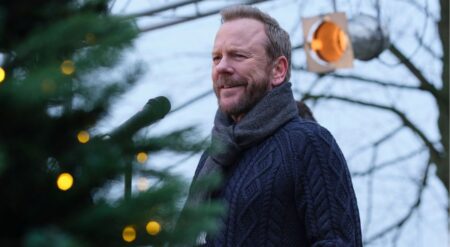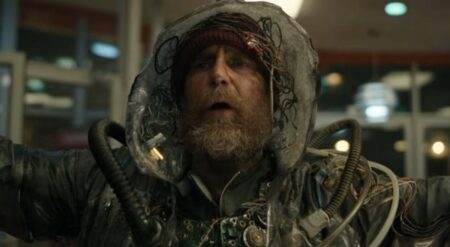
Coming from a cinematography background, Alejandro Loayza Grisi emerges as a brilliant director to keep an eye on with Utama, a gorgeous feature film debut that portrays the effect of climate change in a remote location that is barely covered by traditional media. The film follows Virginio (José Calcina) and Sisa (Luisa Quispe), an elderly Quechua couple whose daily routine is disturbed by a long drought and the arrival of their young grandchild Clever (Santos Choque) who tries to convince them to go to the city with him, not only because of the lack of water in the zone but because of Virginio’s health condition.
“We are starting to see the consequences of climate change. And when you have a tool as powerful as cinema that can reach many viewers, you can’t ignore that responsibility,” told us Loayza Grisi, who mixes his environmental message with a tender love story.
Loayza saw Luisa Quispe and José Calcina standing outside their home while on a location scouting trip and immediately tried to recruit them as Utama’s leads. Once the deed was done, Loayza had to work hard to convince them to fight during important scenes of the film because they are a real couple.
“[They] have been married for a long time, and they say they’ve never fought. It was very difficult for them to raise their voices or treat each other a little badly,” said Loayza. “During the filming of those scenes, they would look at each other with a complicit smile.”
Utama had its world debut at the 2022 Sundance Film Festival where it’s competing on the World Cinema Dramatic program. And to find out more about this exquisite cultural tale of environmentalism, love, and tradition, I spoke with director Alejandro Loayza Grisi about shooting at 4,200 meters above sea level, the crucial sound design, the tricky scenes involving llamas, working with a real-life couple, the meaning of the condor in Bolivia, and much more.
But Why Tho?: To give a bit of context, could you tell me about the current situation of the Quechua culture in Bolivia?
Alejandro: The Quechua culture is very extensive and has many subcultures. There are different groups that speak Quechua but they’ve all had different histories. In the case of the town of Colcha Ka, which is where we filmed, it is a very large municipality that does have drought problems every year that are getting worse and worse.
But Why Tho?: Maybe this sounds silly, but one of the first things that come to mind when I think of La Paz is the World Cup Qualifiers because when other South American countries go to play in La Paz, all the players have a very tough time due to the altitude. So, for you and your crew, what were the difficulties of shooting at 4,200 meters above sea level in the Bolivian Highlands? It sounds quite difficult.
Alejandro: For those of us who are used to it and live in La Paz, it is not very serious. But the Uruguayan crew suffered a lot in the first days because they came from sea level; the man who carried the steadicam suffered a lot from lack of oxygen. But I think that the most difficult thing was the specific climatic conditions of that place: the sun is very high and heats a lot during the day, while at night it gets too cold, so we had to film as if we were in the desert. That was the difficult part, spending all hours of filming covering ourselves from the sun.
But Why Tho?: This is a great slow-burn love story. How did you work with actors José Calcina and Luisa Quispe to portray this? They are a real couple in real life, so what tactics did you use in the scenes where they are fighting?
Alejandro: Those were very difficult because they are a real couple and have been married for a long time, and they say they’ve never fought. It was very difficult for them to raise their voices or treat each other a little badly; during the filming of those scenes, they would look at each other with a complicit smile.
The acting process with them was a very nice learning process for me and them, we rehearsed two months before the start of shooting. We went over the emotional part over and over again, so they already knew how they had to treat the emotions of the scenes.
But Why Tho?: A moving sign of affection throughout the film is Sisa collecting the stones that Virginio constantly brings to her. It’s a symbol of their love. Where did this idea come from?
Alejandro: The little stones thing is something very personal because I used to travel a lot in Bolivia and I always picked them out and brought them to my ex-girlfriend. I still have a large collection of stones at home because I love them, and I think they are very nice objects that remind you of the place where they come from.
But Why Tho?: You are (or were) a director of photography, how was the process of delegating that job to someone else, in this case, the experienced Barbara Álvarez?
Alejandro: It was difficult in pre-production because I couldn’t completely grasp the idea of handing over that responsibility to someone else and I was very afraid that they wouldn’t solve it like I would and make me get involved. But Barbara is awesome, she is very good, and it was a relief because I was able to completely forget about tasks like the lighting; I was able to blindly trust her and focus on the direction itself. It took a weight off my shoulders. We complemented each other very well: together we reviewed all the storyboards that I had prepared and when we talked, we were always watching the same movie and that was very important during the shooting.
But Why Tho?: The framing of Virginio and Sisa’s room was tremendous. The numerous overhead shots of the two beds with each character sleeping separately and later on together in one bed were beautiful. Can you tell me about the cinematography behind this?
Alejandro: At the start of the process, we wanted to use a real house for the shooting, but obviously nobody wanted to lend us their houses, so we built one with some amenities in mind regarding the camera. Both rooms had a retractable wall that we could take out to get more space for the camera shots and we also had beams where we knew we were going to put the overhead camera.
Those shots you mention are very important to me in the film because they signal the dynamics of the couple. The moment she lies down next to him, it’s a moment in which she understands everything that is happening and she conveys that everything will be fine.
But Why Tho?: Throughout “Utama”, Don Virginio’s breathing is very important, it’s omnipresent at times. How did you work with your sound team regarding the creation of the sound atmosphere?
Alejandro: We knew that Virginio’s breathing was very important, we wanted it to be present all the time because through his breathing we live what he lives in the story. One of the great things about the film is that the Uruguayan co-producer has a sound post-production studio. So, to be on set, he also worked as a boom operator. Usually, sound designers only get the material and they work with it, but in this case, he was present in the shooting: he knew the place, he knew how it sounded or didn’t sound, he knew the winds and the two of us had a lot of time to work together because when I was doing the editing, I was stranded in Uruguay due to the pandemic. We had many weeks talking and polishing the work. He has a wonderful team in Uruguay that managed to transport us to that particular sound space.
But Why Tho?: What was the most difficult scene to film?
Alejandro: The most difficult was undoubtedly the fall of the llama. Obviously, we did it with the supervision of a veterinarian and put it to sleep. The llama, for some reason, crossed the entire herd and fell on the other side of where we intended it to. And of course, we couldn’t repeat this process many times. We tried to do a retake at the end of the shoot, but it didn’t turn out very well either. I wanted to have the fall on the frame, but I just couldn’t, however, I think the scene works because of all the dramatic construction around it.
But Why Tho?: Was that the same llama that Clever has to carry?
Alejandro: Yes, it is the same llama. And of course, that was very difficult for Santos. It weighed about 30 or 40 kilos. We planned how to do it with a doll or something along the lines, but he wanted to do it with the llama so that we could see the weight in him. And I think it turned out very well.
But Why Tho?: Tell us about the importance of the condor. It’s a very important symbol in Utama, but what does it represent for Bolivia?
Alejandro: The condor is a sacred animal, it’s the guardian of the mountains. They venerated it because from its height it can visualize the entire terrain and see water. The story that Virginio tells Clever is also something that has been going on for a long time: they believe that the death of the condor is symbolic: it’s the beginning of a new cycle. Furthermore, in Bolivia, the authority of a town is called “Mallku” which means “condor” in Quechua and Aymara. Unfortunately, the condor is an animal in danger of extinction, so in the film, it symbolizes the relationship with the cultures that may disappear due to globalization and climate change, and with Virginio himself.
But Why Tho?: How was the scene between the condor and Virginio created?
Alejandro: The condor is real, but it’s footage. The visual effects studio, which is called Aparato and is in Uruguay, was in charge of the scene. It does have its risks, especially for cinematographers that are not used to special effects. The supervision of effects to film on set, thinking and imagining how all will turn out, is something that we are not very familiar with in Latin America yet.
But Why Tho?: What’s the role of filmmakers regarding environmental issues? At Sundance, there are three Latin American films that tackle, from different approaches, the environmental problem.
Alejandro: I believe that the responsibility of a filmmaker is to tell stories and reflect what is happening. As a storyteller, you have to be aware of what’s going on. It’s an important moment because we are starting to see the consequences of climate change due to human behavior. And I think that when you have a tool as powerful as cinema that can reach many viewers, you can’t ignore that responsibility.
Utama had its world premiere at Sundance 2022. You can follow the film’s path on Instagram (@utama_pelicula).


![[EXCLUSIVE] Palia Devs Dive Into Winterlights, New Tints, Lunar Paths, And More From Upcoming Patch Palia Winterlights Patch](https://butwhytho.net/wp-content/uploads/2025/12/Palia-Winterlights-But-Why-Tho-450x247.jpg)



